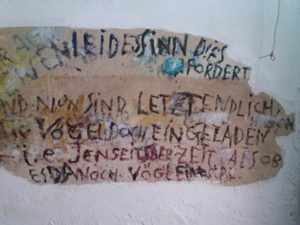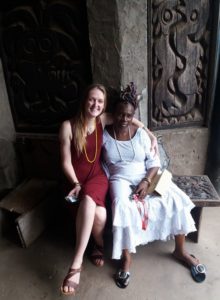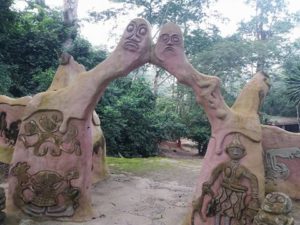Guest post by Anne Maabjerg Mikkelsen

Adunni Oloriṣa’s handwriting on the wall in her former gallery where I slept. Written in German: “Nun sind letztendlich die Vögel doch eingeladen”, English translation: “Now, the birds are yet finally invited.”
“Why do you have to travel so far, Anne?” This was the first reaction from my beloved grandmothers as I told them I would be travelling to Nigeria with the University of Potsdam in October.
I understand their fears. Nigeria does not have a positive reputation in Denmark because of reports of kidnappings, corruption, diseases, and terror. However, I had to go not just because of my master’s thesis about the Ọ̀ṣun-Òṣogbo Sacred Grove, a UNESCO World Heritage Site since 2005, in Ọ̀ṣun State south-western Nigeria, but because something in Nigeria had been calling my soul.
While writing my thesis about the Grove back in Europe, I struggled with the fact that I had not been there on my own. As I realized that the field trip had been organized, it seemed too good to be true. We were a group of ten people including our professor, who had gotten an invitation letter from the University of Ìbàdàn. Most of our program was scheduled on the University’s campus, and it was a relief to leave for Òṣogbo with the group during the second weekend, since I was longing to see the Grove.
Back home, I had already studied Yorùbá culture, and the playful universe of the Òrìṣàs; the deities of a traditional West African religion manifested as energies and natural forces on the earth. The work and worldview of Àdùnní Olóriṣà (1915-2009), the guardian of the Grove, also known as Susanne Wenger, an Austrian modernist artist who was resident in Nigeria and initiated into the Òrìṣà religion, had also caught my attention. I only expected my visit to the Grove to be overwhelmingly magical. And so it was.
Entering the Grove, I could feel my whole body vibrating and getting charged with the intense energy that flourishes around – the powers of Ọ̀ṣun, the Òrìṣà of fertility, beauty and wealth embodied as the Ọ̀ṣun River, who is in everything there, as she nourishes all.
As the group returned to Ìbàdàn the next day, I stayed in the house of Àdùnní Olórìṣà on Ìbòkun Road with her daughter Doyin Ọlọ́ṣun, an Ọ̀ṣun high priestess, for another three days.
Everything felt so natural, and it was more or less like meeting family. We went to the Grove every day and sat by the River listening to the water curving its way through the virgin forest, sharing dreams and beliefs as the sun made its way through the clouds and sent its warm rays to the surface of the river from where they were gently directed to us. We greeted the monkeys in the green trees around us and the fish that made their arrival as we sat down. Everything here is sacred; no fish can be caught, no animal hunted or tree cut down. No wonder that Àdùnní gave her life to protect this place and the Òrìṣà religion.
It was with a heavy heart and tears in my eyes that I had to leave Òṣogbo, Doyin and her family in the house.
Before Nigeria, I was told that, “the person that went to Nigeria is not the same one that came back.” I must agree. Knowing that I have gotten the permission from the closest people, I feel capable to write my thesis not just through my mind but also with my heart. Moreover, I had the feeling that my thesis was more than just a paper, which would allow me to finish my degree.
My trip to Nigeria reaffirmed that it is also a personal path of self-discovery, and I am certain that I will return. There is much more to tell, still so many questions to be asked, and so many people to thank, among others: Professor Hans-Georg Wolf for organizing the trip; Níke Davies-Okundaye for her open heart; Kọ́lá Túbọ̀sún for his time; Dr Ọbáfẹ́mi Jẹ́gẹ́dẹ́ and the African Studies of University of Ìbàdàn; Robin Campbell from the Susanne Wenger Trust for helping me organize my stay; site manager of the Grove, Mr Olákúnlé Mákindé; and of course my deepest thanks to Doyin Ọlọ́ṣun and her family on Ìbòkun Road.
I am now back in Berlin. My beloved grandmothers are relieved and therefore, so am I. I will do my best to explain to them how magical my experience of Nigeria has been, and that not all Nigerians are bad but rather extremely welcoming and warm-hearted. Where I come from, we could learn from this place and from what the Grove represents: that spirituality is beyond race, that nature is divine and sacred, and the importance of cherishing the feminine principle.
This is exactly my answer to the question “Why do you have to travel so far, Anne?”
____
 Anne Maabjerg Mikkelsen, pictured here with Ọ̀ṣun priestess Doyin, is from Denmark. She lives and studies in Berlin Germany, University of Potsdam. She spent two weeks in Nigeria as part of an academic visit.
Anne Maabjerg Mikkelsen, pictured here with Ọ̀ṣun priestess Doyin, is from Denmark. She lives and studies in Berlin Germany, University of Potsdam. She spent two weeks in Nigeria as part of an academic visit.


No Comments to The Person That Went to Nigeria is not The Same One That Came Back so far. (RSS Feeds for comments in this post)
No one has commented so far, be the first one to comment!